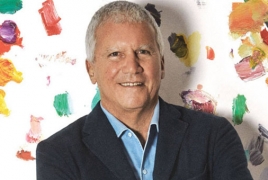
The Wall Street Journal published an extensive article about world-famous art dealer Larry Gagosian who built an empire spanning 16 locations around the globe “by never saying no to his artists’ ambitions.”
With an estimated $1 billion in annual sales, Gagosian works across the contemporary and modern eras, representing living artists like John Currin and Mark Grotjahn while also dealing on behalf of the estates of Alberto Giacometti, Richard Avedon and Helen Frankenthaler.
He exhibits a wide range of work, from Instagram images appropriated by Richard Prince to boulders-as-sculpture by cerebral artist Michael Heizer. At the same time, he conducts sales on the so-called secondary market—a term he hates—by privately buying and selling artworks to clients, the WSJ says.
He was also an early proponent of the museum-quality show within a private gallery, securing sought-after loans of historic works that are often not for sale.
“It was completely a fluke,” says Gagosian of how he got started in the business. He grew up in Los Angeles, the only son of an Armenian family. His mother, Ann Louise, made a living acting and singing, while his father, Ara, was an accountant. His actor uncle, who played a pirate in the 1960 version of Peter Pan, for a time lived in the family’s small downtown apartment along with Gagosian’s sister and grandmother. After his father became a stockbroker, the family upgraded to Van Nuys, in the San Fernando Valley. In high school, Gagosian swam competitively; he continued to swim and play water polo at UCLA until he quit the team his sophomore year.
After earning a B.A. in English literature at 24, he kicked around doing odd jobs in L.A. before getting hired at William Morris Agency, from which he was fired after a year. Without savings, he needed a job and began working as a parking lot manager.
“I’ve always been somebody who just kind of does what’s in front of me,” says Gagosian. So when he observed a man selling posters near the parking lot, he decided to give it a shot and soon discovered he had a knack for selling. “So I started buying more expensive posters,” he says. “Rather than selling something for $15, with the frame it becomes $50 and $100.” Eventually he also started a frame shop, and then rented out a former Hungarian restaurant in Westwood Village in 1976. In this narrow space he opened Prints on Broxton, selling more upscale pieces to fledgling collectors.
One day, while tearing through art magazines, he spotted a graphic black-and-white image by photographer Ralph Gibson. Gagosian looked up Gibson’s number in New York and cold-called to see if he would do a show in L.A. “It was very naive. Ninety-nine percent of the people you got on the phone like that would have blown me off,” he says. “Luckily he was a nice guy.” Gagosian had only been to New York once, as a teenager, but he flew out to meet Gibson, who in turn introduced him to his gallerist, Leo Castelli, who ultimately became the upstart’s mentor and introduced him to collectors. Soon Gagosian had a loft in New York across from Castelli’s space, which he purchased with $10,000 and a Brice Marden painting.
By 1985, Gagosian had opened his own space in New York, in a former truck dock in Chelsea, then a largely ungentrified area full of warehouses.
Finding buyers for pieces that are not officially for sale is a signature Gagosian move, the Journal says.
When Gagosian contemplates a relationship with a new artist, he considers several factors. “It’s about the quality of the work, and it’s about, also, can you sell it?” he says. “Because believe me, that’s what artists want: They want their work to sell. It’s a big responsibility, because you’re their main source of income. So you’ve got to make sure you can do the job. You know, they’re buying their country houses and they’re putting their kids in private schools and they need money, and that makes the world go around.”

